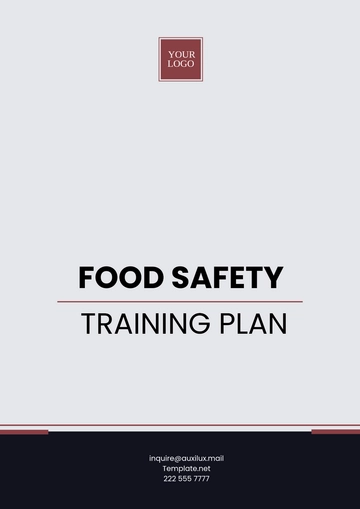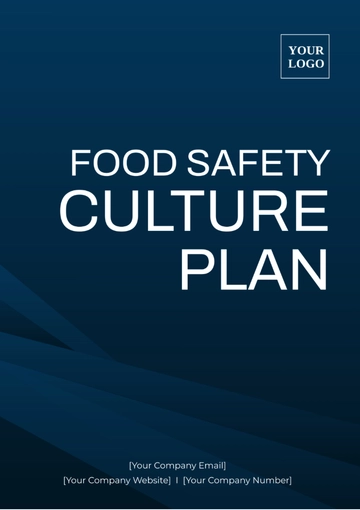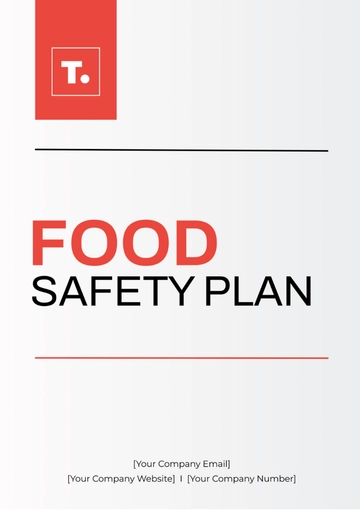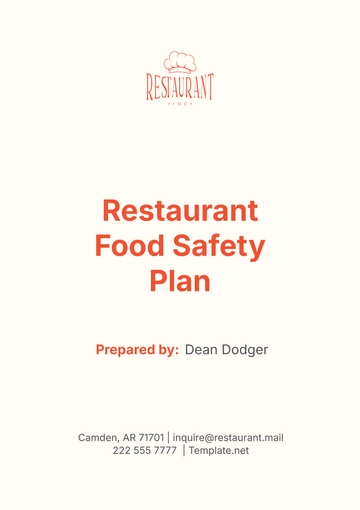Free Food Safety Plan
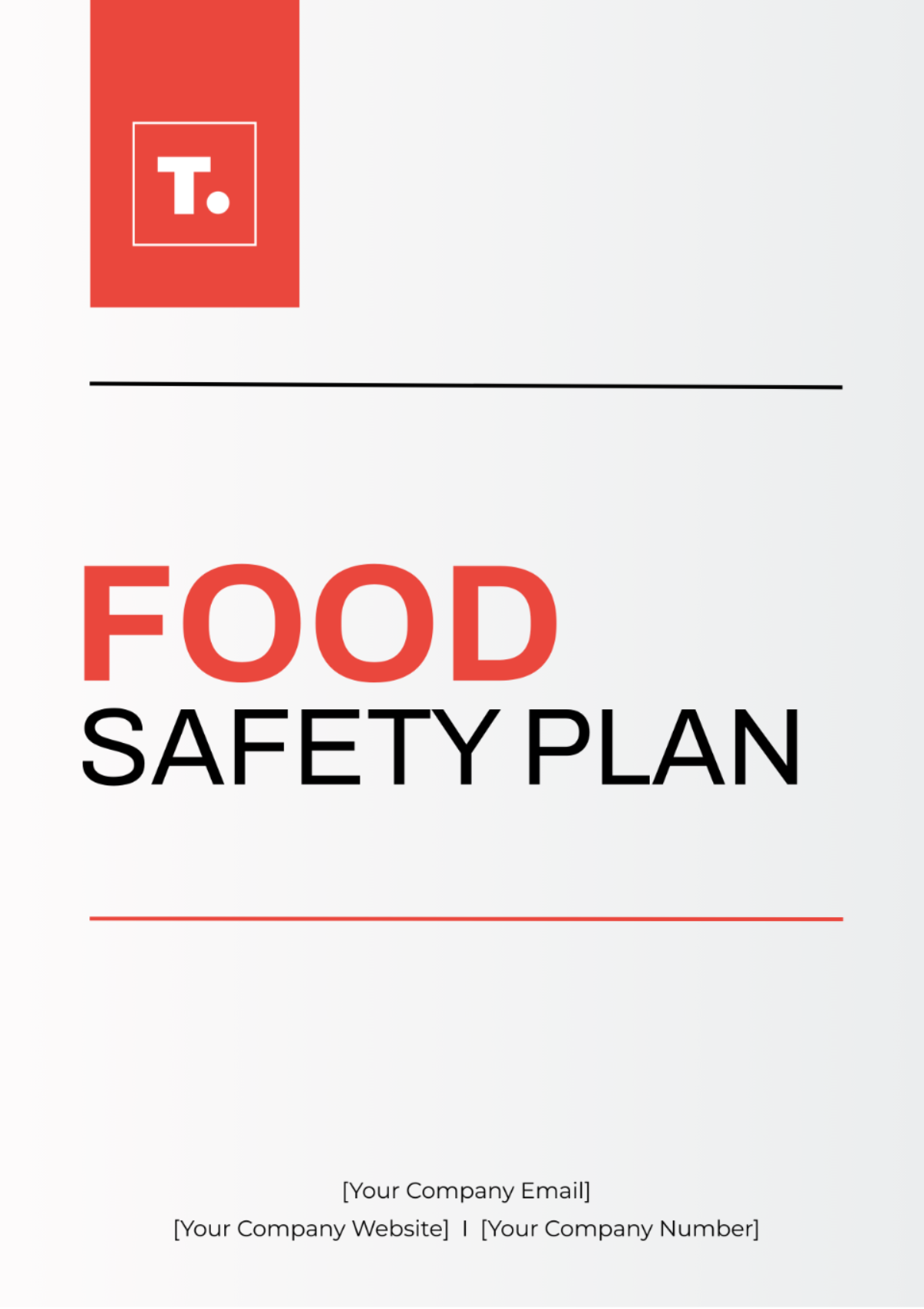
Written by: [Your Name]
I. Introduction
A. Purpose
The purpose of this Food Safety Plan is to ensure that all food handled, prepared, and stored within our facilities is safe and free from contamination to prevent foodborne illnesses.
B. Scope
This plan applies to all employees involved in food handling, including kitchen staff, food handlers, and quality control personnel at [Your Company Name].
II. Roles and Responsibilities
A. Management
Management is responsible for implementing and reviewing the Food Safety Plan regularly. They are also required to ensure that all staff receive proper training.
B. Food Handlers
Food handlers must adhere to all safety procedures detailed in this plan and report any issues or concerns to management immediately.
C. Quality Control Personnel
Quality Control Personnel are tasked with monitoring the efficacy of this Food Safety Plan and making recommendations for improvements.
III. Food Safety Procedures
A. Personal Hygiene
All staff must wash hands thoroughly with soap and water before handling food. Hairnets and gloves must be worn at all times in food preparation areas.
B. Food Storage
Store all food at appropriate temperatures to prevent spoilage. Raw and cooked foods must be stored separately to prevent cross-contamination.
Food Storage Guidelines
Food Type | Storage Temperature | Storage Duration |
|---|---|---|
Perishable | Below 40°F (4°C) | 2-3 days |
Frozen | Below 0°F (-18°C) | Indefinitely |
Dairy Products | 35-40°F (1-4°C) | Follow Expiry |
Raw Meat/Poultry | Below 40°F (4°C) | 1-2 days |
C. Food Handling
Use separate utensils and equipment for raw and cooked foods. Ensure all surfaces are cleaned and sanitized regularly.
Food Handling Guidelines
Use color-coded cutting boards for different food types.
Cook food to the appropriate internal temperatures:
Poultry: 165°F (74°C)
Ground meats: 160°F (71°C)
Seafood: 145°F (63°C)
Leftovers: 165°F (74°C)
IV. Hazard Analysis
A. Identifying Hazards
Identify potential biological, chemical, and physical hazards in the food preparation process.
Types of Hazards
Biological: Bacteria, viruses, parasites.
Chemical: Cleaning agents, pesticides, allergens.
Physical: Foreign objects, such as glass or metal fragments.
B. Risk Assessment
Evaluate the potential impact and likelihood of each hazard occurring. Prioritize hazards that pose the greatest risk.
Risk Assessment Matrix
Hazard | Likelihood | Severity | Risk Level |
|---|---|---|---|
Biological | High | High | High |
Chemical | Medium | Medium | Medium |
Physical | Low | High | Medium |
V. Control Measures
A. Preventative Measures
Implement measures to prevent identified hazards from occurring. This includes proper food storage, hygiene practices, and regular equipment maintenance.
Preventative Measures Checklist
Regular cleaning and sanitizing of food contact surfaces.
Use of food-grade cleaning agents.
Pest control measures.
B. Monitoring
Continuously monitor control measures to ensure they are effective. Document and report any deviations or issues immediately.
Monitoring Procedures
Conduct daily temperature checks of refrigerators and freezers.
Regularly inspect food storage areas for signs of pest infestation.
VI. Emergency Procedures
A. Emergency Contacts
Contact | Phone Number |
|---|---|
Health Department | [Local Health Department's Contact Number] |
Food Safety Officer | [Your Company Name] - [Your Company Number] |
[Your Name] | [Your Emergency Contact Number] |
B. Reporting Incidents
All incidents must be reported to management immediately. Document the incident and perform a root cause analysis to prevent future occurrences.
Incident Reporting Form
Date and time of the incident
Nature of incident (e.g., contamination, injury)
Actions taken to address the incident
Recommendations for prevention
VII. Training and Communication
A. Training Programs
Provide regular food safety training for all staff. Ensure that new employees receive training before beginning work.
Training Schedule
Monthly staff meetings with food safety training modules.
Annual refresher courses on food safety protocols.
B. Communication
Maintain clear communication channels between management, staff, and external authorities. Ensure all safety updates and changes are promptly communicated.
Communication Channels
Staff bulletin board for posting safety updates.
Regular email newsletters with food safety tips and reminders.
VIII. Regular Review and Updates
A. Review Schedule
Review and update this Food Safety Plan at least annually or whenever there are changes in regulations or procedures.
Review Checklist
Check for compliance with new regulations.
Incorporate feedback from staff and quality control assessments.
B. Continuous Improvement
Encourage staff to provide feedback and suggestions for improving food safety practices.
Suggestions Box Implementation
Action | Responsibility | Timeline |
|---|---|---|
Install a suggestions box in the break room | Facility Management | Within 1 week |
Collect and review suggestions monthly | Quality Control Officer | Ongoing, monthly |
Schedule and conduct improvement meetings | Management | Monthly |
- 100% Customizable, free editor
- Access 1 Million+ Templates, photo’s & graphics
- Download or share as a template
- Click and replace photos, graphics, text, backgrounds
- Resize, crop, AI write & more
- Access advanced editor
Ensure food safety with an editable Food Safety Plan Template from Template.net. This customizable template, editable in our AI Tool, helps you maintain high standards of hygiene and safety in food handling and preparation.
You may also like
- Finance Plan
- Construction Plan
- Sales Plan
- Development Plan
- Career Plan
- Budget Plan
- HR Plan
- Education Plan
- Transition Plan
- Work Plan
- Training Plan
- Communication Plan
- Operation Plan
- Health And Safety Plan
- Strategy Plan
- Professional Development Plan
- Advertising Plan
- Risk Management Plan
- Restaurant Plan
- School Plan
- Nursing Home Patient Care Plan
- Nursing Care Plan
- Plan Event
- Startup Plan
- Social Media Plan
- Staffing Plan
- Annual Plan
- Content Plan
- Payment Plan
- Implementation Plan
- Hotel Plan
- Workout Plan
- Accounting Plan
- Campaign Plan
- Essay Plan
- 30 60 90 Day Plan
- Research Plan
- Recruitment Plan
- 90 Day Plan
- Quarterly Plan
- Emergency Plan
- 5 Year Plan
- Gym Plan
- Personal Plan
- IT and Software Plan
- Treatment Plan
- Real Estate Plan
- Law Firm Plan
- Healthcare Plan
- Improvement Plan
- Media Plan
- 5 Year Business Plan
- Learning Plan
- Marketing Campaign Plan
- Travel Agency Plan
- Cleaning Services Plan
- Interior Design Plan
- Performance Plan
- PR Plan
- Birth Plan
- Life Plan
- SEO Plan
- Disaster Recovery Plan
- Continuity Plan
- Launch Plan
- Legal Plan
- Behavior Plan
- Performance Improvement Plan
- Salon Plan
- Security Plan
- Security Management Plan
- Employee Development Plan
- Quality Plan
- Service Improvement Plan
- Growth Plan
- Incident Response Plan
- Basketball Plan
- Emergency Action Plan
- Product Launch Plan
- Spa Plan
- Employee Training Plan
- Data Analysis Plan
- Employee Action Plan
- Territory Plan
- Audit Plan
- Classroom Plan
- Activity Plan
- Parenting Plan
- Care Plan
- Project Execution Plan
- Exercise Plan
- Internship Plan
- Software Development Plan
- Continuous Improvement Plan
- Leave Plan
- 90 Day Sales Plan
- Advertising Agency Plan
- Employee Transition Plan
- Smart Action Plan
- Workplace Safety Plan
- Behavior Change Plan
- Contingency Plan
- Continuity of Operations Plan
- Health Plan
- Quality Control Plan
- Self Plan
- Sports Development Plan
- Change Management Plan
- Ecommerce Plan
- Personal Financial Plan
- Process Improvement Plan
- 30-60-90 Day Sales Plan
- Crisis Management Plan
- Engagement Plan
- Execution Plan
- Pandemic Plan
- Quality Assurance Plan
- Service Continuity Plan
- Agile Project Plan
- Fundraising Plan
- Job Transition Plan
- Asset Maintenance Plan
- Maintenance Plan
- Software Test Plan
- Staff Training and Development Plan
- 3 Year Plan
- Brand Activation Plan
- Release Plan
- Resource Plan
- Risk Mitigation Plan
- Teacher Plan
- 30 60 90 Day Plan for New Manager
- Food Safety Plan
- Food Truck Plan
- Hiring Plan
- Quality Management Plan
- Wellness Plan
- Behavior Intervention Plan
- Bonus Plan
- Investment Plan
- Maternity Leave Plan
- Pandemic Response Plan
- Succession Planning
- Coaching Plan
- Configuration Management Plan
- Remote Work Plan
- Self Care Plan
- Teaching Plan
- 100-Day Plan
- HACCP Plan
- Student Plan
- Sustainability Plan
- 30 60 90 Day Plan for Interview
- Access Plan
- Site Specific Safety Plan
